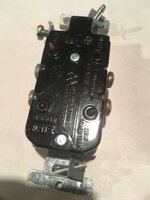Came across this receptacle with no way to release the live and neutral wires. I pulled hard on the wires and both broke, leaving stubs in the receptacle. There was enough extra length of wires in the box, so all I had to do was strip some insulation off the wires and attach them to the new receptacle, using the side screws. The old receptacle failed because of the back stabbing.
On the back of
 the old receptacle is - Smith and Stone, Made in Canada.
the old receptacle is - Smith and Stone, Made in Canada.
On the back of

 the old receptacle is - Smith and Stone, Made in Canada.
the old receptacle is - Smith and Stone, Made in Canada.